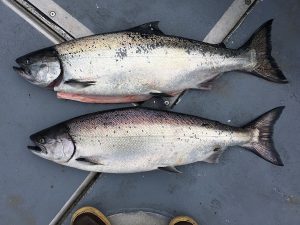Bycatch of Nearly 20,000 Chinook Salmon Shuts Down Alaska Pollock Fishery
 Nearly 20,000 Chinook salmon were accidentally caught as bycatch in the Gulf of Alaska’s pollock fishery, forcing an early closure and igniting outrage among scientists studying endangered southern resident orcas and advocates for wild salmon. Chinook salmon, highly prized for their size and nutritional value, are a critical food source for the southern resident orcas that frequent the Salish Sea.
Nearly 20,000 Chinook salmon were accidentally caught as bycatch in the Gulf of Alaska’s pollock fishery, forcing an early closure and igniting outrage among scientists studying endangered southern resident orcas and advocates for wild salmon. Chinook salmon, highly prized for their size and nutritional value, are a critical food source for the southern resident orcas that frequent the Salish Sea.
Although genetic testing of the caught Chinook has not yet been completed, it is highly likely that fish from Washington’s rivers were among those captured. Pollock, a white fish commonly used in products like fish sticks and fast-food sandwiches, was the intended target of the fishing operation.
The shutdown came after just two fishing vessels surpassed the allowable bycatch limit during the weekend of September 21-22. According to Julie Fair, a spokesperson for the Alaska region of the National Oceanic and Atmospheric Administration (NOAA), the boats were monitored by either onboard human observers or cameras. Starting next year, the entire fleet will be subjected to this level of monitoring.
Observers at shoreside processing plants counted each Chinook salmon caught and collected genetic samples. The fish were either donated to food banks or discarded onshore. The trawl fleet had a bycatch limit of 18,316 Chinook salmon, but this season saw 19,486 fish accidentally caught. When captains realized the extent of the bycatch, they voluntarily shut down the fishery.
This early closure is expected to have severe economic consequences for the fishing and processing communities, particularly those based in Kodiak, AK. Julie Bonney, executive director of the Alaska Groundfish Data Bank, explained that the fishery, which was scheduled to run until November 1, will now leave 50,000 metric tons of pollock in the sea, resulting in potential financial hardship for many. “There will be people who struggle to make insurance and boat payments,” Bonney said, adding that the closure compounds existing challenges, including low seafood prices, industry bankruptcies, and closures.
“This is an unprecedented situation,” Bonney said, noting that the cap on Chinook bycatch, set in 2012, had never been exceeded until now. “They hit an extraordinary surge of salmon.”
Misty MacDuffee, wild salmon program director for the Raincoast Conservation Foundation in British Columbia, highlighted the troubling implications of catching immature Chinook salmon. The pollock trawl fishery, she said, is indiscriminate, catching salmon regardless of their age or size. The Gulf of Alaska is a key nursery for salmon from Washington rivers, and the bycatch of younger, smaller fish threatens the future of Chinook populations, which are already under strain.
Orcas depend on larger, older Chinook, usually four years or older and over 29 inches long, for sustenance. However, most of the Chinook caught as bycatch were much smaller, averaging only three pounds. MacDuffee warned that this trend is shifting the structure of the salmon population toward younger, smaller fish, depriving southern resident orcas of the large Chinook they need to survive. “We don’t have a problem with abundance, but with the population structure. How do we return to having large, old fish?” she asked.
MacDuffee suggested shifting fisheries to river mouths, allowing orcas a better chance at catching the fish first. This approach could still provide opportunities for human fishing while prioritizing the orcas’ needs. She argued that fishing regulations, designed in the 1980s to allocate fish abundance, are outdated in the face of today’s salmon, biodiversity, and climate crises. “People understand the threats better than ever, but we’re not yet willing to make the necessary changes,” MacDuffee said.
The situation is dire for southern resident orcas, with scientists warning that the species is heading toward extinction. A recent paper coined the term “Bright Extinction” to describe the phenomenon, in which extinction occurs not due to ignorance but because society fails to act despite understanding the problem.
Deborah Giles, science and research director of the nonprofit Wild Orca, stressed the need to ensure enough Chinook salmon for both orcas and human fishers. More than 69% of orca pregnancies are lost due to nutritional stress, with not enough big, old Chinook to feed the endangered population of 73 southern resident orcas. Giles suggested that one possible solution would be paying fishers not to fish, giving salmon populations a chance to recover while still supporting fishing families.
The issue of bycatch has reached a critical point as Chinook salmon become increasingly vital for the survival of endangered orcas. Both Washington state and the federal government have committed millions of dollars to a wild predator feeding program, aimed at releasing millions of hatchery-raised Chinook to sustain the orca population. From 2008 to 2023, the National Oceanic and Atmospheric Administration (NOAA) released 158 million hatchery Chinook into the Salish Sea, the coasts of Washington and Oregon, and the Columbia River. Despite these large-scale efforts, both wild Chinook salmon and the southern resident orca population remain on the brink of extinction.
 Maritime Injury Law Blog
Maritime Injury Law Blog

